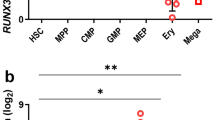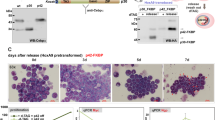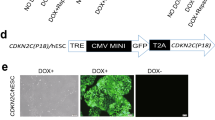Abstract
Human SET encodes a nuclear phosphoprotein with a highly acidic carboxyl-terminus, forming a SET-CAN fusion gene in a patient with acute undifferentiated leukemia. SET is highly conserved between species and is ubiquitously expressed, suggesting a widespread biological role. Even though SET is involved in chromatin remodeling and transcriptional activation, its precise role in hematopoietic cells and the contribution of SET-CAN to leukemogenesis remains unknown. We determined the effect of tetracycline-regulatable expression of SET, a deletion mutant of SET, and SET-CAN on the human promonocytic cell line U937T. The expression of SET and SET-CAN inhibited proliferation of these cells. SET accomplishes this through the induction of the differentiation program, an effect that depends on the presence of its acidic domain. SET-CAN most likely inhibits growth by interfering with hCRM1, but it also partially blocks differentiation. Our results are the first demonstration of a potential role of SET in hematopoietic differentiation.
This is a preview of subscription content, access via your institution
Access options
Subscribe to this journal
Receive 12 print issues and online access
$259.00 per year
only $21.58 per issue
Buy this article
- Purchase on Springer Link
- Instant access to full article PDF
Prices may be subject to local taxes which are calculated during checkout


Similar content being viewed by others
References
von Lindern M, Breems D, van Baal S, Adriaansen H, Grosveld G . Characterization of the translocation breakpoint sequences of two DEK-CAN fusion genes present in t(6;9) acute myeloid leukemia and a SET-CAN fusion gene found in a case of acute undifferentiated leukemia. Genes Chromosomes Cancer 1992; 5: 227–234.
Fornerod M, Boer J, van Baal S, Jaegle M, von Lindern M, Murti KG et al. Relocation of the carboxyterminal part of CAN from the nuclear envelope to the nucleus as a result of leukemia-specific chromosome rearrangements. Oncogene 1995; 10: 1739–1748.
Adachi Y, Pavlakis GN, Copeland TD . Identification and characterization of SET, a nuclear phosphoprotein encoded by the translocation break point in acute undifferentiated leukemia. J Biol Chem 1994; 269: 2258–2262.
Nagata K, Saito S, Okuwaki M, Kawase H, Furuya A, Kusano A et al. Cellular localization and expression of template-activating factor I in different cell types. Exp Cell Res 1998; 240: 274–281.
Kim EG, Choi ME, Ballermann BJ . Spatially restricted expression of set mRNA in developing rat kidney. Am J Physiol 1994; 266: F155–161.
von Lindern M, Poustka A, Lerach H, Grosveld G . The (6;9) chromosome translocation, associated with a specific subtype of acute nonlymphocytic leukemia, leads to aberrant transcription of a target gene on 9q34. Mol Cell Biol 1990; 10: 4016–4026.
Okuwaki M, Nagata K . Template activating factor-I remodels the chromatin structure and stimulates transcription from the chromatin template. J Biol Chem 1998; 273: 34511–34518.
Seo SB, Macfarlan T, McNamara P, Hong R, Mukai Y, Heo S et al. Regulation of histone acetylation and transcription by nuclear protein pp32, a subunit of the INHAT complex. J Biol Chem 2002; 277: 14005–14010.
Cervoni N, Detich N, Seo SB, Chakravarti D, Szyf M . The oncoprotein Set/TAF-1beta, an inhibitor of histone acetyltransferase, inhibits active demethylation of DNA, integrating DNA methylation and transcriptional silencing. J Biol Chem 2002; 277: 25026–25031.
Fan Z, Beresford PJ, Oh DY, Zhang D, Lieberman J . Tumor suppressor NM23-H1 is a granzyme A-activated DNase during CTL-mediated apoptosis, and the nucleosome assembly protein SET is its inhibitor. Cell 2003; 112: 659–672.
Saito S, Miyaji-Yamaguchi M, Shimoyama T, Nagata K . Functional domains of template-activating factor-I as a protein phosphatase 2A inhibitor. Biochem Biophys Res Commun 1999; 259: 471–475.
Adler HT, Nallaseth FS, Walter G, Tkachuk DC . HRX leukemic fusion proteins form a heterocomplex with the leukemia-associated protein SET and protein phosphatase 2A. J Biol Chem 1997; 272: 28407–28414.
Compagnone NA, Zhang P, Vigne JL, Mellon SH . Novel role for the nuclear phosphoprotein SET in transcriptional activation of P450c17 and initiation of neurosteroidogenesis. Mol Endocrinol 2000; 14: 875–888.
Boer J, Bonten-Surtel J, Grosveld G . Overexpression of the nucleoporin CAN/NUP214 induces growth arrest, nucleocytoplasmic transport defects, and apoptosis. Mol Cell Biol 1998; 18: 1236–1247.
Munker R, Zhang W, Elstner E, Koeffler HP . Vitamin D analogs, leukemia and WAF1. Leukemia Lymphoma 1998; 31: 279–284.
Ayton PM, Cleary ML . Molecular mechanisms of leukemogenesis mediated by MLL fusion proteins. Oncogene 2001; 20: 5695–5707.
Yoshida Y, Anzai N, Kawabata H . Apoptosis in normal and neoplastic hematopoiesis. Crit Rev Oncol Hematol 1996; 24: 185–211.
Acknowledgements
We thank Dr Richard Ashmun and Dr Ann Marie Hamilton-Easton for FACS analysis, Dr Andrew Hollenbach for help with the paper, Dr Irina Lagutina for suggestions regarding immunocytochemistry and Dr Terry Copeland for SET antibody. This work was supported by NIH Grant CA76480-05, the Cancer Center (CORE) Support Grant CA-21765, and the American Lebanese Syrian Associated Charities (ALSAC) of St Jude Children's Research Hospital.
Author information
Authors and Affiliations
Corresponding author
Rights and permissions
About this article
Cite this article
Kandilci, A., Mientjes, E. & Grosveld, G. Effects of SET and SET-CAN on the differentiation of the human promonocytic cell line U937. Leukemia 18, 337–340 (2004). https://doi.org/10.1038/sj.leu.2403227
Received:
Accepted:
Published:
Issue Date:
DOI: https://doi.org/10.1038/sj.leu.2403227
Keywords
This article is cited by
-
Cyclin-dependent kinase 1-mediated phosphorylation of SET at serine 7 is essential for its oncogenic activity
Cell Death & Disease (2019)
-
Phenotypic and genetic characterization of adult T-cell acute lymphoblastic leukemia with del(9)(q34);SET-NUP214 rearrangement
Annals of Hematology (2012)
-
SET and PARP1 remove DEK from chromatin to permit access by the transcription machinery
Nature Structural & Molecular Biology (2007)
-
SET-induced calcium signaling and MAPK/ERK pathway activation mediate dendritic cell-like differentiation of U937 cells
Leukemia (2005)



